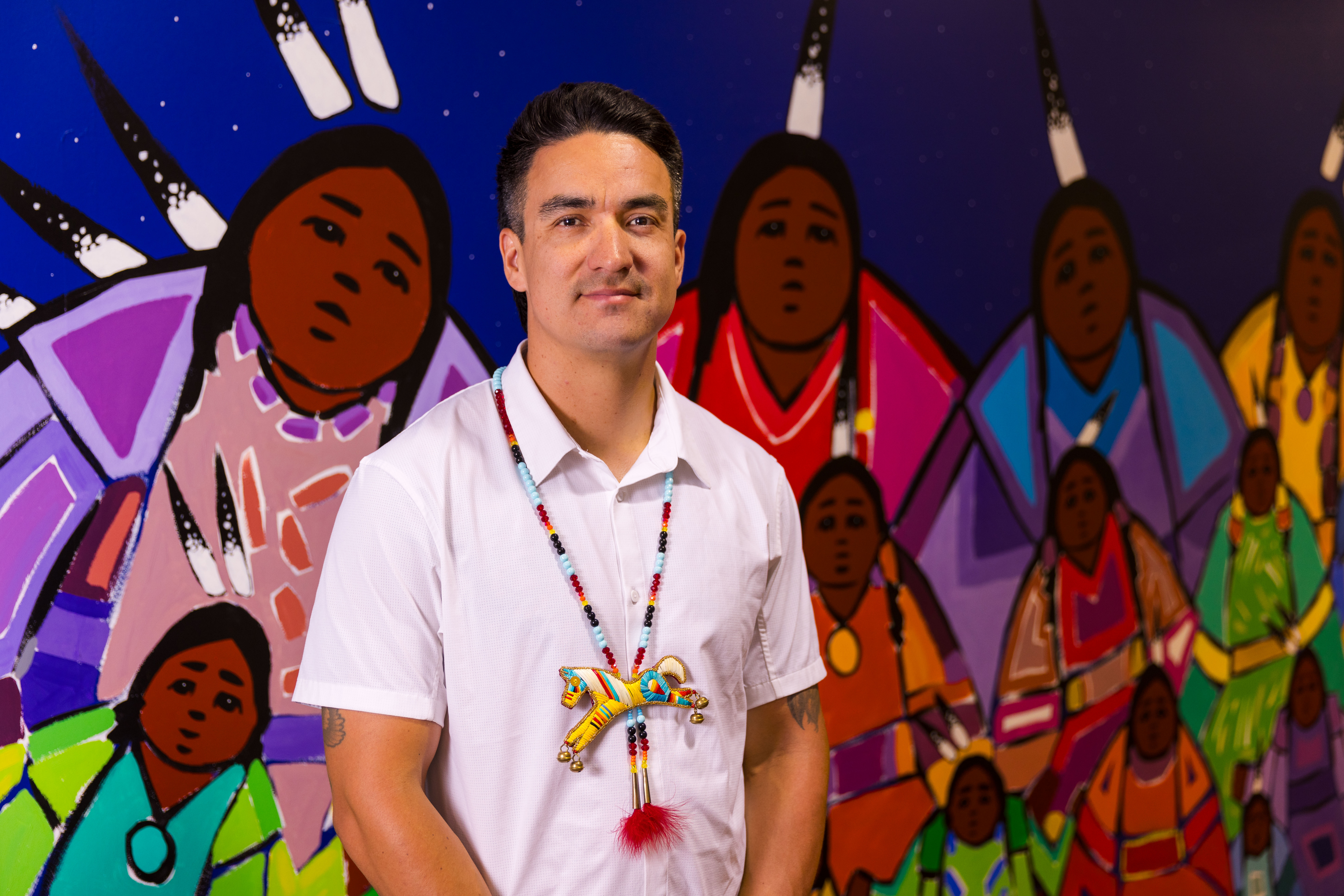Q & A with Grant Bruno
27 September 2024

This month, we had the pleasure of chatting with Dr. Grant Bruno, who was recently appointed as an Assistant Professor in the Department of Pediatrics. We learned more about him, his research, and his goals as he moves forward in his new role.
Can you tell us a little bit about yourself?
Tansi Grant Bruno nitsîhkôson nipîsihkopahk Maskwacîs ohcî niya. Hello, my name is Grant Bruno, and I am a registered member of Samson Cree Nation, one of the First Nations that makes up Maskwacîs, Alberta. Situated on Treaty 6 Territory (roughly an hour’s drive south of Edmonton) Maskwacîs is a nêhiyaw (Plains Cree) community. I am also a son to a residential school survivor and father to Autistic children. My ceremony name is osâwasatim which translates as Yellow Horse. My families are the Cutknifes, Lightnings, and Brunos. I also have connections to Enoch Cree Nation and Papaschase First Nation.
What led you to focus on autism within First Nations communities, and why do you think this area of research is important?
My focus on autism within First Nations communities comes from a deep personal and professional commitment to addressing the unique challenges that Indigenous peoples face in healthcare, especially in areas like neurodevelopmental disorders that are often underserved and misunderstood. Growing up, I witnessed firsthand the gaps in culturally responsive healthcare within Indigenous communities, and I became increasingly aware that conditions such as autism were not only underdiagnosed but often misunderstood in these contexts. This led to many families lacking access to the appropriate support and resources they needed.
I believe research in autism within First Nations communities is critical because it aims to bridge the gap between Western biomedical approaches and Indigenous ways of knowing. Historically, colonial healthcare systems have overlooked Indigenous perspectives on disability and neurodiversity, which perpetuates inequities and fails to acknowledge the strengths and resilience of First Nations families. By focusing on autism, I hope to challenge these gaps and advocate for a more inclusive, culturally responsive framework that respects and integrates First Nation worldviews.
Could you share more about the Ispimihk Awâsisak Program and how this initiative hopes to enhance the health and well-being of Indigenous children and families?
The Ispimihk Awâsisak Program, which translates as ‘sky children’ in the nêhiyâwin (Plains Cree) language, was named in a ceremony with môsom Rick Lightning. This five-year initiative is currently based in Maskwacîs (encompassing the Louis Bull, Ermineskin Cree, Samson Cree, and Montana Nations) and will expand to include other communities in Treaty Six over time. It is an initiative dedicated to enhancing the health and well-being of Indigenous children, youth, and their families at the community level. Affiliated with WCHRI, this program embraces a community-led research approach to develop, implement and evaluate impactful health initiatives.
The Ispimihk Awâsisak Program is guided by the nêhîyaw concept of wâhktotowin, emphasizing relationality and interconnectedness. Key community principles include relationality, community-centred, reciprocity, meaningful engagement, equitable partnerships, respect and action-oriented. These principles ensure that the program’s outcomes are relevant and beneficial to the communities served.
Your research takes a community-led approach- can you tell us a little more about what that entails and why you choose to use this approach in your research?
My research takes a community-led approach because I believe that the best solutions for First Nations communities come from within the communities themselves. This approach involves working closely with families, Elders, and community leaders to ensure that their knowledge, experiences, and perspectives guide the research process from start to finish. Rather than imposing outside frameworks or solutions, I prioritize listening to the community’s needs and co-developing strategies that are culturally relevant and meaningful to them.
In practice, this means engaging in ongoing dialogue with community members, building trust, and ensuring that the research is beneficial to the people it seeks to serve. It also means recognizing the expertise that exists within Indigenous communities and respecting traditional knowledge systems. By involving communities in every aspect of the research, from identifying the questions to be addressed to interpreting the results, I ensure that the outcomes are not only scientifically sound but also aligned with the values and priorities of the people who will be most affected.
What are your goals moving forward both in your new role as a faculty member in the department and in your work as a researcher and program lead of the Ispimihk Awâsisak Program?
My goals are centered around advancing both Indigenous health and autism research while fostering meaningful relationships between academic institutions and First Nations communities.
As a researcher, I aim to continue building culturally responsive frameworks for autism diagnosis and care in First Nations communities, ensuring that our work is guided by the voices and experiences of Indigenous families. My goal is to create more equitable health systems where First Nations children with autism are understood and supported in ways that honor their cultural identity and family structures. I plan to expand the scope of my research to explore the intersectionality of autism with other social and health determinants, such as trauma, intergenerational impacts of colonization, and mental health challenges within Indigenous communities.
Through the Ispimihk Awâsisak Program, I plan to continue supporting community-led initiatives that empower Indigenous families. My long-term goal is to establish more community-based programs that build capacity and enhance services for children with neurodevelopmental disorders, ensuring these programs are sustainable and aligned with the values of the communities they serve.
In my new faculty role, I am committed to mentoring the next generation of healthcare professionals, especially First Nations students and those interested in working with First Nations populations. I see this as an opportunity to bring more awareness to the unique healthcare needs of First Nations peoples within medical education, while advocating for culturally safe care practices and decolonized approaches to healthcare.